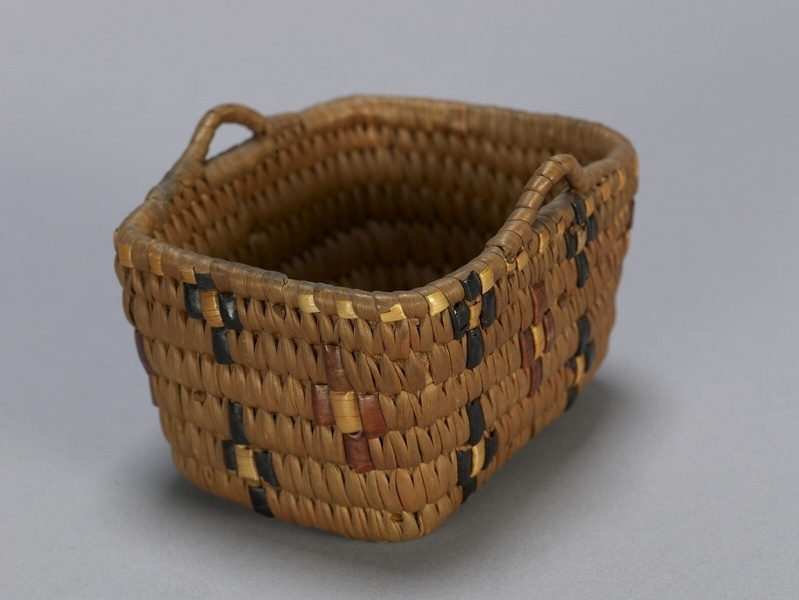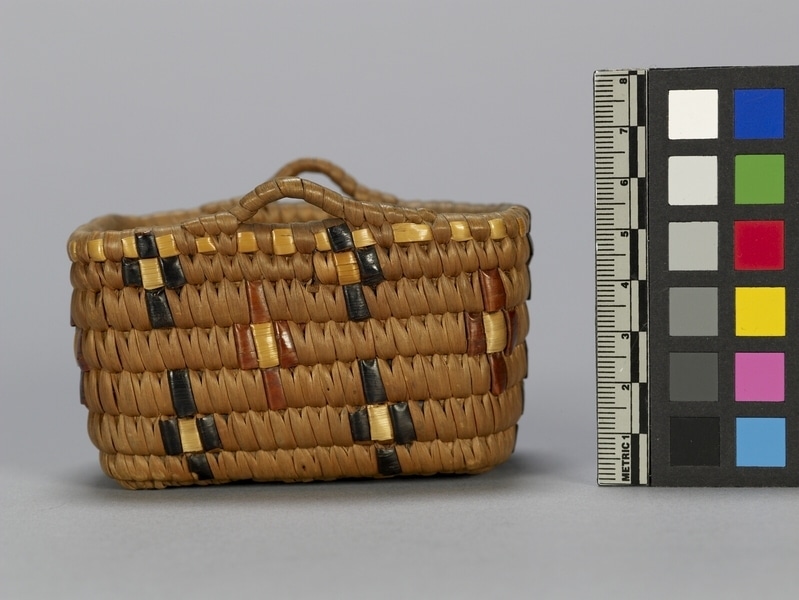Trinket Basket Item Number: A7617 from the MOA: University of British Columbia



Description
Tan basket with simple interlocking coiled work (bifurcated stitches), parallel slat base foundation with single reinforcement stitch, and an overcast rim looped to form two handles. Decorated with imbrication and beading. Imbricated discrete cross-shaped figures arranged in three horizontal rows in red cherry bark/cat-tail grass and in black-dyed bark/cat-tail grass staggered. Middle row in red cherry bark/cat-tail while the others are in black cherry bark/cat-tail.
History Of Use
Coiled basketry traditionally had many uses. It was used for storage of foods, medicines and personal belongings. Some baskets were used for cooking and boiling water, while others had more private uses. Haeberlin and Teit (1928) suggest that in the past not all women were basket makers, but that the skill became more widespread during the early and middle twentieth century when basketry was highly collectible and it became a source of income for many local First Nations women. Basket making declined after the 1950s, but it is still present in many Coast Salish communities and interest is growing.
Cultural Context
basketry
Item History
- Made in British Columbia, Canada during 1881
- Collected in Harrison Lake, British Columbia, Canada ? during 1881
- Owned by William Rowe
- Owned by Margaret Ades before August 17, 1961
- Received from Margaret Ades (Seller) and H. R. MacMillan (Funding source) on August 17, 1961
What
- Name
- Trinket Basket
- Identification Number
- A7617
- Type of Item
- basket
- Material
- cedar root, dye, cherry bark and cat-tail grass ?
- Manufacturing Technique
- coiled and imbricated
- Overall
- height 5.1 cm, width 7.6 cm, depth 5.7 cm
Who
- Culture
- Coast Salish: Sto:lo ?
- Previous Owner
- William Rowe and Margaret Ades
- Received from
- Margaret Ades (Seller) and H. R. MacMillan (Funding source)
Where
- Holding Institution
- MOA: University of British Columbia
- Made in
- British Columbia, Canada
- Collected in
- Harrison Lake, British Columbia, Canada ?
When
- Creation Date
- during 1881
- Collection Date
- during 1881
- Ownership Date
- before August 17, 1961
- Acquisition Date
- on August 17, 1961
Other
- Item Classes
- basketry
- Condition
- good
- Current Location
- Case 29
- Accession Number
- 0055/0059